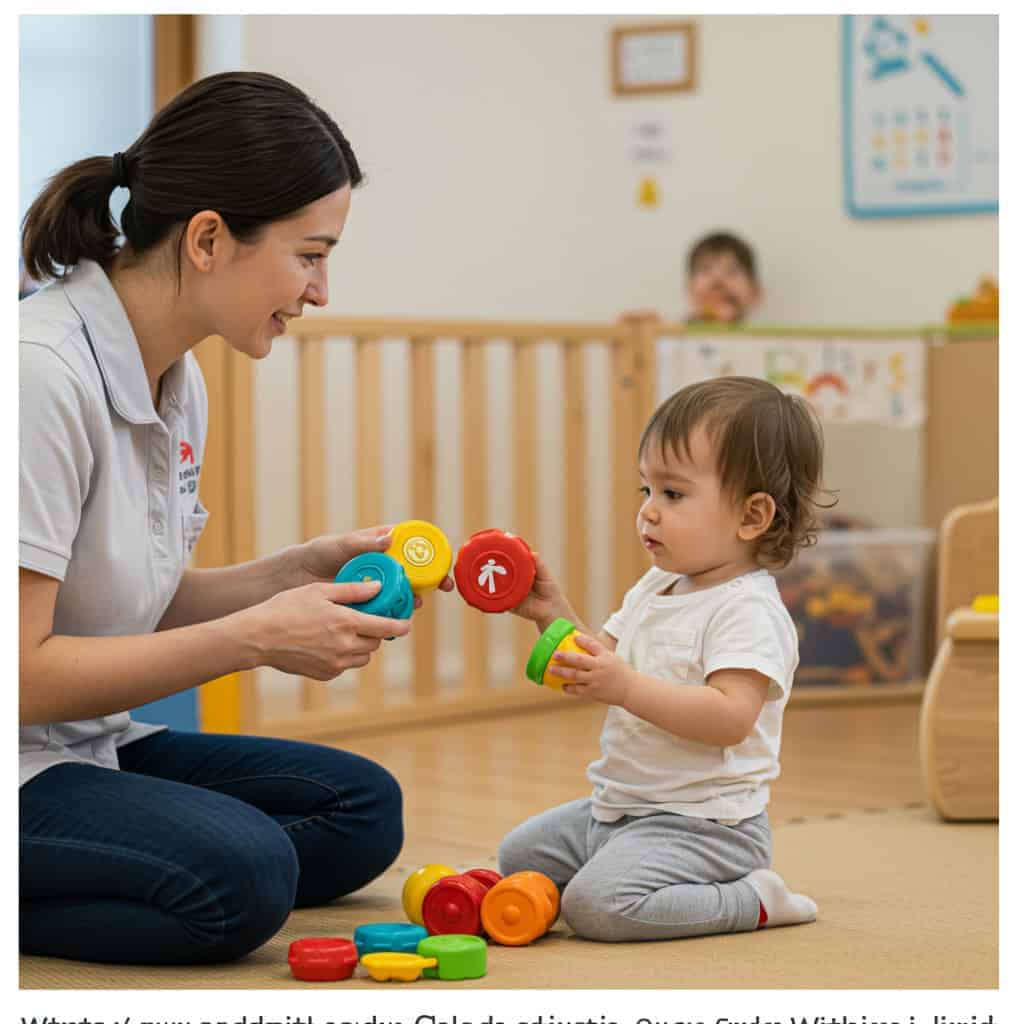How to Say ‘No’ to a Toddler Without Sparking a Meltdown
When setting boundaries with toddlers, providing concise and age-appropriate explanations is crucial. Clear communication helps prevent confusion and reduces the likelihood of tantrums. For instance, instead of saying, “Don’t touch that,” you might say, “Thank you for keeping your hands where they are! These items are very fragile.” This approach not only sets clear expectations but also acknowledges positive behavior, fostering understanding and cooperation. (pathways.org)
Offering Choices Within Limits

Providing toddlers with controlled choices can foster cooperation while still setting boundaries. For example, instead of a rigid refusal like “No, you can’t have a cookie now,” offer alternatives such as “You can have a banana or some yogurt.” This approach empowers toddlers by giving them a sense of control within acceptable limits, reducing the likelihood of tantrums. Offering choices helps children develop decision-making skills and a sense of autonomy, which can lead to better behavior and fewer meltdowns. (firstthingsfirst.org)
Staying Calm and Consistent

Maintaining a calm tone and consistent responses when setting boundaries with toddlers is essential for fostering trust and security. Children are sensitive to emotional cues; overreacting or inconsistent reactions can escalate their anxiety and confusion. For instance, if a parent alternates between strict enforcement and leniency, a child may become uncertain about expectations, leading to increased testing of limits. Consistent and calm responses, on the other hand, provide a predictable environment where children feel safe and understand the consequences of their actions. This approach not only reduces anxiety but also teaches children about self-regulation and respect for boundaries.
Acknowledging Feelings

Validating and naming a toddler’s emotions is crucial in preventing meltdowns. By recognizing their feelings, children feel heard and understood, which can reduce frustration and anxiety. For example, instead of dismissing a child’s anger by saying, “Don’t be mad,” you might say, “I see you’re upset because we have to leave the park.” This approach acknowledges their emotion and the reason behind it, fostering trust and emotional intelligence. Validating emotions helps children learn to identify and manage their feelings, leading to better emotional regulation and fewer outbursts.
Using Positive Language

Rephrasing negative statements into positive language can promote cooperation and reduce resistance in toddlers. For example, instead of saying, “Don’t run in the house,” you might say, “Please walk inside the house to keep everyone safe.” This approach provides clear expectations and encourages desired behavior. Similarly, instead of “Don’t draw on the table,” you can say, “Crayons are for coloring on paper. Let’s use this paper to create your masterpiece.” Such positive language guides children toward appropriate actions while maintaining a supportive environment. (wellan.org)
Maintaining Predictable Routines

Establishing and adhering to consistent routines offers toddlers a sense of security, aiding transitions and making limits more acceptable. Predictable schedules help children understand expectations, manage their time, and develop healthy habits. For instance, a consistent bedtime routine not only helps children wind down for sleep but also provides a comforting ritual that signals the end of the day. This predictability can be especially soothing for children who may find transitions challenging or experience anxiety. (ph.theasianparent.com)
Keeping Body Language in Check

Maintaining positive body language is essential when communicating with toddlers, as it reinforces verbal messages and helps prevent misinterpretation or fear. Key strategies include:
Maintain Eye Contact: Looking at your child during conversations signals attentiveness and interest, making them feel valued. (famly.co)
Use Open Posture: Avoid crossing arms or turning away; instead, keep your posture relaxed and open to convey receptiveness. (aussiechildcarenetwork.com.au)
Smile Genuinely: A warm smile can reassure toddlers and make interactions more comfortable. (mindchamps.org)
Mirror Expressions: Reflecting your child’s facial expressions, such as smiling when they do, shows empathy and understanding. (aussiechildcarenetwork.com.au)
Use Gentle Gestures: Light touches or nods can convey support and attentiveness, enhancing the connection. (raisingchildren.net.au)
By consciously managing your body language, you create a supportive environment that fosters trust and effective communication with your toddler.
Setting Realistic Expectations

Establishing age-appropriate boundaries is essential for toddlers, as it provides them with a sense of security and helps them understand acceptable behaviors. Expecting behaviors beyond their developmental stage can lead to frustration and meltdowns. For instance, toddlers (ages 1-3) are still developing impulse control and may not understand the concept of sharing. Setting expectations that align with their abilities, such as “We use gentle hands with the puppy,” is more effective. This approach fosters cooperation and reduces the likelihood of tantrums. (wohum.org)
Modeling Self-Regulation

Demonstrating self-regulation during stressful moments is crucial, as toddlers often learn by observing adults. (arizonafamilycounseling.com) For instance, if a child sees a caregiver pause, take deep breaths, and calmly address a situation, they are more likely to imitate this behavior. This modeling teaches children effective ways to manage their emotions and responses, fostering emotional intelligence and resilience. Consistently exhibiting self-control provides a clear example for toddlers to follow, aiding in their development of self-regulation skills.
Establishing Clear Boundaries

Setting unambiguous, gentle boundaries provides toddlers with a sense of safety and helps them understand expectations. Using clear and simple language is essential; instead of saying, “Don’t run inside,” you might say, “We walk inside to keep everyone safe.” This approach communicates the desired behavior directly and positively. Maintaining a calm and firm tone reinforces the message without causing confusion or fear. Consistency in enforcing these boundaries further solidifies understanding and trust.
Being Mindful of Timing and Triggers

Recognizing and planning around factors like hunger, tiredness, or overstimulation is crucial when delivering a ‘no’ to toddlers. These conditions can heighten irritability and reduce a child’s ability to cope with limits. For instance, a child who is hungry may become more prone to tantrums when denied a treat. Ensuring your child is well-rested and has had adequate nutrition can make them more receptive to guidance. Additionally, being aware of environmental stimuli that might overwhelm your child allows you to adjust situations proactively, reducing the likelihood of meltdowns. (first5california.com)
Using Distraction Creatively

Engaging toddlers in playful distractions can effectively redirect their focus and prevent meltdowns. Here are some innovative ideas: Implementing these creative distractions can help toddlers manage their emotions constructively, leading to fewer meltdowns and a more harmonious environment.
Practicing Empathy and Patience

Responding to toddlers with empathy and patience fosters trust and cooperation. For instance, acknowledging a child’s frustration by saying, “I understand you’re upset because we have to leave the park,” validates their feelings and opens a dialogue. In contrast, reacting with impatience, such as raising your voice or expressing frustration, can escalate the situation and lead to increased resistance. By consistently modeling calm and understanding responses, caregivers teach children effective emotional regulation and problem-solving skills, promoting a more harmonious relationship. (understood.org)
Following Up with Comfort and Reassurance

After setting a boundary or saying ‘no,’ it’s essential to provide comfort and reassurance to help your toddler process their emotions and maintain trust. Here are some strategies to consider:
Stay Close and Regulate Yourself: Your calm presence is powerful. Sit nearby, breathe slowly, and let your body language say, “You’re safe.”
Acknowledge Without Fixing: Validate their feelings by saying, “You’re feeling really upset right now.” Avoid rushing to stop the crying—validation helps them feel seen.
Use a Soft, Rhythmic Voice: Speak slowly and gently. A soothing tone can help regulate their nervous system.
Offer a Comforting Object: A soft toy, blanket, or sensory item can provide grounding and familiarity.
Minimize Stimulation: Dim lights, reduce noise, and clear the space if needed. A calm environment supports emotional recovery.
Mirror Their Breathing (When Ready): Once the crying slows, model slow, deep breaths. Toddlers often mirror your rhythm when they’re ready.
Use Gentle Touch (If Welcomed): A hand on the back or a cuddle can be reassuring—but always follow their cues.
Redirect with Purpose: When they’re ready, offer a calming activity like water play, playdough, or a favorite book.
Narrate the Moment: “You were sad when Mum left. That’s really hard. Now we’re together, and we’re safe.” This helps them make sense of their feelings
Debrief Later: Once calm, revisit the moment gently. This builds emotional literacy and trust. (aussiechildcarenetwork.com.au)
Implementing these strategies can help toddlers manage their emotions constructively, leading to fewer meltdowns and a more harmonious environment.
Conclusion

Establishing clear, consistent boundaries with toddlers fosters a sense of security and promotes cooperation. Approaches such as offering choices within limits, modeling self-regulation, and practicing empathy and patience are effective strategies. (captainsteward.com) By implementing these mindful and respectful techniques, caregivers can minimize emotional distress and create a nurturing environment that supports healthy development for both children and adults. (familienportal.nrw)
.article-content-img img { width: 100% }




